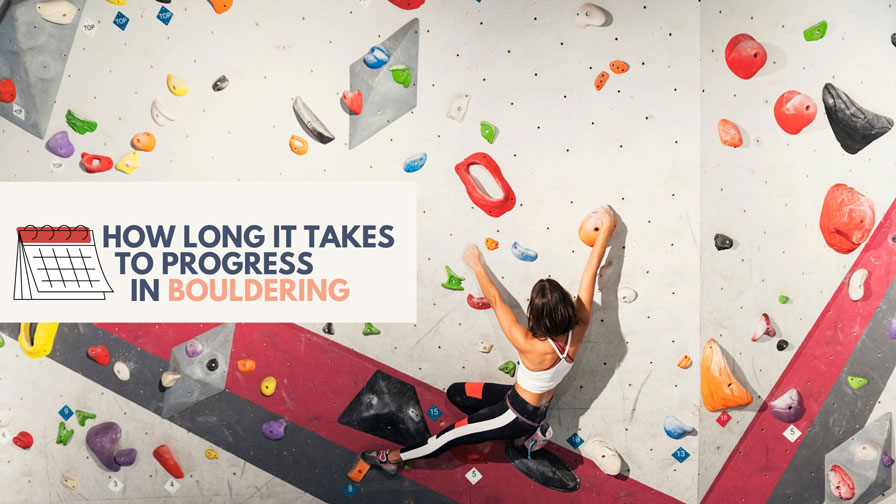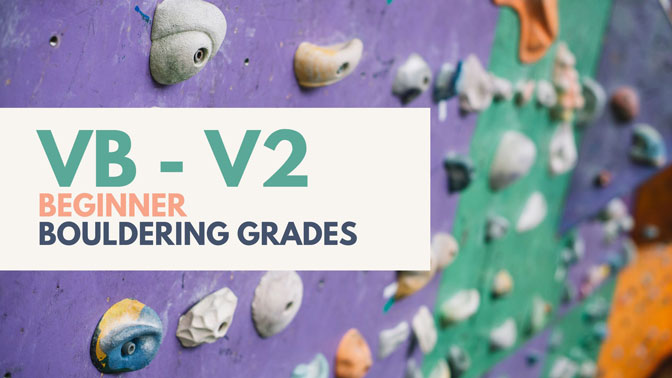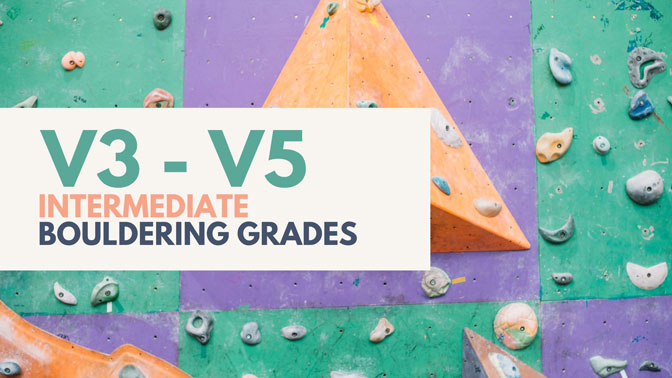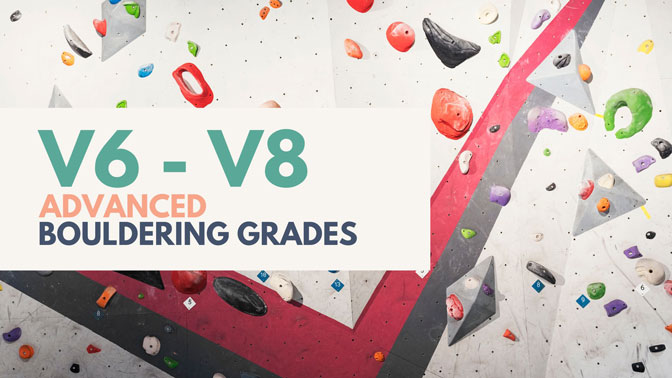Ever wondered how long it takes to progress through the bouldering grades? How long it takes to go from beginner to intermediate grades? How long it takes to get to V3? Or how long it takes to get to V5?
This article covers everything you need to know about bouldering progression. We’ll look at how long it takes to progress through certain bouldering grades and finish off with some tips to help your own progression.
To write this post, I interviewed friends and random climbers at my local gym in combination with some forum posts I found on this topic. To get my averages, I asked climbers how long it took to progress from V3 – V4, how to get past the beginner grades, and so forth. I interviewed both men and women, tall and short climbers as well as larger and stronger climbers.
Throughout my interviews, I encountered very different levels of progression. Some climbers can send problems within days that other climbers take a whole year to accomplish. For this reason, please keep in mind that everyone has their own rate of progression. There is nothing wrong with progressing slower than usual, as long as you are having fun bouldering!

Jump this article
- How long to progress through Beginner Grades
- V0 – V1
- V1 – V2
- How long to progress through Intermediate Grades
- V2 – V3
- V3 – V4
- V4 – V5
- How long to progress through Advanced Grades
- V5 – V6
- V6 – V7
- V7 – V8
- Tips for Bouldering Progression
Before we start…
Bouldering progression depends on several factors
Everyone progresses bouldering at their own pace. Some climbers have initial advantages over others when they start, which gives them a head start. How quickly a boulderer will progress, will depend upon the following factors.
- BMI (Body Mass Index) – Someone with a lower BMI is going to progress faster than someone with a higher BMI as they have less bodyweight to carry during climbs.
- Genetics – some people are genetically stronger than others, this is going to provide an advantage in bouldering.
- Strength – aside from genetics, strenth can be trained as well. If you are physically strong, you are going to progress very quickly in bouldering as you can use your strength to force yourself through grades.
- Height – tall climbers have an advantage over shorter climbers in bouldering. This is especially noticeable during the initial bouldering grades. I’ve seen tall climbers skip multiple hand holds on V1 and V2 bouldering problems, essentially turning them into ladders.
- Your previous sport – someone who comes to bouldering with a calisthenics or gymnastics background is going to have a major advantage when progressing through the bouldering grades
- Fear factor – someone who isn’t afraid of heights, or afraid to push themselves, is going to progress much faster.
- How much focus you place on technique – some boulderers are more serious than others. Those who tend to research climbing techniques and pay attention to others tend to progress much faster than those who don’t.
- Frequency – how often you attend a bouldering gym, has a major impact on how quickly you will progress. Boulderers who come in 3 times per week are going to impress much faster than someone who only comes in once or twice per month.
- Not getting injured – an injury can set you back a long time. Some injuries take months to heal so this can set your progress back a long time.

Keep in mind that Bouldering Gyms Grade Soft
The grading that is used in bouldering gyms, is very different from the grading you’ll experience outdoors. Bouldering gyms tend to grade very soft to promote progression. This keeps the climbers happy and the subscriptions active. This is especially common in commercial climbing gyms. Commercial climbing gyms exist to make money and thus the grades are going to be way softer than their outdoor counterparts.
In many cases, an indoor grade differs 2 whole grades from an outdoor grade.
For this reason, you should stay humble and never compare your indoor climbing grade with outdoor grades or even compare them with other climbing gyms.
Bouldering is about having fun, not grade chasing
Whether you boulder indoors, outdoors, or both, it’s all about having fun. Don’t let grades get in your way of having fun. Chasing grades isn’t everything. Everyone wants to see progression but if you are constantly going to be focused on the next grade, you are never going to enjoy content with your current climbing.
One lady I interviewed had been stuck at V2 – V3 for 1.5 years. Due to her busy schedule, she can only boulder for 1 hour every week. While this might sound unsatisfying to the grade-chases reading this article, she is actually perfectly content with her abilities and enjoys doing beginner boulder problems. She’s always climbing with a smile and has made friends with some of the biggest crushers at our gym.
How long does it take to progress through the Beginner Grades?

Beginner grades in bouldering range from VB/V0 to V2.
VB – V1 Progression (3 – 5)
An average beginner boulderer will be stuck to VB and V0 grades during their first indoor bouldering session and potentially subsequent sessions as well. It’s completely normal to feel stuck in the beginner grades when you are first starting out.
How long does it take to go from VB – V1?
Once they are over the initial hump, most boulderers tend to progress into V1 in their first month of bouldering.
| VB – V1 | 1 month |
V1 – V2 Progression (5 – 5+)
Once V1 is achieved, boulderers tend to quickly reach V2 as well. The average boulderer will send most V2s by the end of their first or second month.
This is of course the progression of an average boulderer, some boulderers may struggle for longer and require up to 3 months to finally send a V2 graded boulder. While other boulderers might have the required strength to send V2 boulders during their first bouldering session.
How long does it take to go from V1 – V2?
| V1 – V2 | 1 week – 2 months |
read next: what does ‘send‘ mean in bouldering?
Beginner Bouldering Grades Converted
To make this article easier to read, I’ve written the article from a V-scale perspective but also added the Font grading as well. After each section, I will add a V-scale to font-scale conversion.
| VB | V0 | V1 | V2 |
| 3 | 4 | 5 | 5+ |
more info: converting Font to V bouldering grades
Tips for V1 – V2 Boulder Progression
Here are some tips for those struggling to get past the beginner grades. Please keep in mind that being stuck within this grade range is normal during your first month(s) of bouldering.
1. Get the mileage
Mileage is what climbers use to refer to being on the wall. Getting mileage is especially important in the beginner stages because it helps you adjust to your new hobby. Many beginners will make the mistake of avoiding the grades they can climb in favor of higher level grades which they are not. Getting out of your comfort zone is good but at the very start, you want to spend as much time on the wall as possible. For this reason, you should focus on repeating the easy climbs as much as possible. This is called ‘getting mileage’ and will help your technique tremendously.
2. Climb often
If you are serious about progressing in bouldering, you should visit your bouldering gym at least once per week (2 visits per week is ideal, 3 at most). This helps build muscle memory and makes your body comfortable with climbing. If you take long breaks between sessions, you might have to start over every time and thus progress very slowly.
3. Pay attention to other boulderers
One of the best ways to learn, is to pay attention to others. While you are watching other boulderers, you are getting familiar with their climbing techniques, which you can copy in your own climbs! You’d be surprised how much you pick up simply by looking. Watching others is also a great way to acquire beta for your boulder problems.
How long does it take to move through the Intermediate Bouldering Grades?

Intermediate grades in bouldering range from V3 to V5.
V2 – V3 Progression (5+ – 6a)
On average, boulderers reach V3 in their first 3 – 6 months of climbing. Some physically strong climbers might reach certain V3s during their first couple of sessions. If doing pull-ups is no big deal, a physically strong climber will be able to use their arms to send most V3 graded problems.
How long does it take to go from V2 – V3?
While going from V0 – V2 goes fairly quickly, V3 is the first grade that stands as a challenge for many climbers. It could take anywhere from 1 – 4 months to go from V2 to V3.
| V2 – V3 | 1 – 4 months |
V3 – V4 Progression (6c – 6b)
Going from V3 to V4 is where many boulderers see their first plateau. While V3 is pretty easy if you can rely on your arms, V4 requires better technique to be able to send most problems. V4 grades have worse holds, oftentimes require beta, finger strength, and sometimes might even have a dyno at the crux.
read next: what does ‘beta’ mean in bouldering?
How long does it take to go from V3 – V4?
V3 – V4 might pose the first plateau for some climbers. Progression can take anywhere from 3 – 6 months for a fit boulderer who climbers frequently. Some boulderers may take up to a year to reach this grade range.
| V3 – V4 | 3 – 6 months |
V4 – V5 Progression (6b – 6c)
V4s are a great introduction to technical climbing which should set you up well for V5s. Once you can easily send V4s and maybe even flash some, you can start looking at V5 climbs.
read next: what does ‘flash’ mean in bouldering?
How long does it take to go from V4 – V5?
Progression from V4 – V5 will take anywhere from 3 – 12 months. The average boulderer can expect to climb V5 after a year or two of indoor bouldering.
| V4 – V5 | 3 – 12 months |
Intermediate Bouldering Grades Converted
| V3 | V4 | V5 |
| 6a | 6b | 6c |
Tips for V1 – V5 Boulder Progression
1. Practise intermediate techniques
Techniques such as flagging and understanding body tension are going to help while progressing through the intermediate bouldering grades. You should inform yourself and practise these techniques on easier climbs so that they will become second nature to you.
2. Study the different holds
Going from beginner to intermediate grades will introduce you to a lot of new holds (crimps, slopers, pinches, etc). It’s important that you know how to use these holds. Only with proper technique, will you be able to use these holds to your advantage to send your problems. You can ask other climbers at your gym for tips or learn all about the different types of bouldering holds from YouTube videos.
3. Train your body
While you shouldn’t be using the hangboards or campus boards yet at this grade level, you can start doing exercises which will help promote growth.
Here are some of the best exercises for intermediate climbers:
- Pull ups
- Push ups
- Core excercices
- Shoulder excercices (low weight dumbbels)
These are exercises that can easily be done at your bouldering gym or practised at home. Most bouldering gyms have a pull-up bar. We recommend that every boulderer gets a yoga mat for core exercises as well as stretches. If you are serious, you might consider buying a pull-up bar that fits on your door frame.
How long does it take to move through the Advanced Bouldering Grades?

Advanced grades in bouldering range from V6 to V8.
V5 – V6 Progression (6c – 7a)
Many climbers reach a big plateau at V5. After all, not many boulderers even reach this grade level. That’s why we differentiate between ‘intermediate’ and ‘advanced’ grades. While V5 is attainable for most boulderers who climb regularly within 2 years, V6 is an entirely different ballpark.
While V5 can be achieved through learning the proper climbing technique, V6 requires a certain level of fitness. So if you are a strong climber, you might not notice a big difference in progression between these grades but if you are not physically fit, you will struggle for sure.
Though even if you are fit enough, you might not have the required finger and tendon strength to send V6 boulders right away. These boulder problems tend to be very heavy on the fingers (with the introduction of small pocket holds). For this reason, getting into V6 grades could require some finger training such as hangboarding.
How long does it take to go from V5 – V6?
As V6 climbs require a level of fitness, progression from V5 – V6 can take anywhere from a couple of months to up to a year or even more. A fit boulderer might reach V6 within a year of training while the average boulderer will require at least 2 years of climbing to reach this grade range.
| V5 – V6 | 6 – 12 months |
V6 – V7 Progression (7a – 7a+)
I’ve noticed that if you didn’t experience a big leap from V5 – V6, you will likely plateau from V6 – V7. Whereas if you plateaued between the previous grade range, you might find it easier to progress from V6 – V7.
This has a lot to do with how gyms grade their boulders. Some gyms have V6 problems that would be considered ‘intermediate grades’ by most climbers whereas other gyms have V6 problems that would be considered ‘advanced grades’.
How long does it take to go from V6 – V7?
Progression from V6 – V7 should take at least 1 year or more. You might be able to hit some softly graded V7s shortly after reaching V6 but most climbers will reach another plateau in this grade range.
| V6 – V7 | 1 year+ |
V7 – V8 Progression (7a – 7b/+)
V8 is the final grade that is considered ‘advanced’ territory, progressing past that puts you into ‘expert’ bouldering territory. For this reason, V8 (and beyond) are grades that are considered out of reach for many boulderers.
It can take years before V8 is even in the cards. To reach V8, a lot of physical strength is required. So if you haven’t done any type of training before reaching V7, you will definitely have to incorporate a hang boarding and/or campus boarding routine for this next tier.
How long does it take to go from V7 – V8?
Climbers who have reached V7 can reasonably reach V8 within 2 years with proper training. Many climbers might need more time.
| V7 – V8 | 2 years+ |
Advanced Bouldering Grades Converted
| V6 | V7 | V8 |
| 7a | 7a+ | 7b/7b+ |
Typical Bouldering Progression timeline
Every climber has their own rate of progression. Some climbers are genetically inclined to progress much faster than others. While other climbers have extra disadvantages such as height or weight that might slow down their progression.
That being said, I’ve compiled some data from my climbing gym as well as users on Reddit to find the typical bouldering progression timeline for someone who climbs 2 – 3 times a week.
Here’s what I found out:
| Boulder Grades | Progression timeline |
|---|---|
| V0 – V1 | 1 month |
| V0 – V3 | 1/2 – 1 year |
| V0 – V5 | 1 – 2 years |
| V0 – V6 | 2 – 3 years |
| V0 – V7 | 3 – 4 years |
| V0 – V8 | 5 – 8 years |
| V0 – V9 | 7+ years |
| V0 – V10 | 9+ years |
Again, this table is purely based on averages. Some climbers reach V8 in their first year of climbing while other climbers will never send a V8 boulder.
That being said, this table should pose a realistic example of what is achievable within 10 years for a climber who climbs 2 – 3 days a week.
Tips for Progressing Boulder Grades
Try climbing different styles
Sticking within your own climbing style can definitely limit your growth as a boulderer. If you are good at slab climbing but stuck at steep overhung terrain, that is exactly what you should be focusing on. Always try out bouldering grades within each climbing style (vertical, slab, overhang) to improve in each style. Never limit yourself!
If you have to go below your grade on overhang terrain, this is all the more reason to expand your horizon and get comfortable with overhung boulder problems.
Figure out which style suits you most
You’ve probably heard someone say “this problem fits my style” before. This is not something you should worry about at the very start but once you start getting to the intermediate grades, you will become aware of your climbing style. Maybe you are an explosive climber who is great at dynamic moves such as the deadpoint or maybe you are a slow and controlled climber. Whichever you are, it helps knowing your strong suits so you can look for projects that fit your style.
Go boulder outdoors
Nothing will humble you more than an outdoor bouldering trip. Are you a V3 boulderer? Haha, you’ll be lucky if you can do a V1 outside. Jokes aside, outdoor boulders are going to force you to get out of your comfort zone, which will help you progress in the climbing gym. Spoiler alert: outdoor boulders are much scarier. No longer do you have a chunky mat underneath you to protect your fall.
Climb in different gyms
Like I mentioned earlier, bouldering grades are different from gym to gym. While you might be a V3 climber in your own gym, it’s very possible you can’t do a V3 in another gym. Not only is the grading different, they also have different route setters.
You’d be surprised how much your ‘bouldering progress’ is tied to you becoming more familiar with your gym’s route setters. After all, the more you climb at your gym, the more you become familiar with the setting style of your gym. By going to another gym, you are going outside of your comfort zone and trying boulder problems set by different setters. This too, is going to help you progress your bouldering.
Train your body
Most boulders can reach the intermediate grades without doing any type of physical training outside of climbing. But to make the leap from intermediate to advanced grades, you will likely need to train outside of climbing.
For this reason, many climbers start using the hangboards and campus boards within their climbing gyms after about a year of bouldering. There is a reason you will find these in just about any climbing gym, they work!
Hangboarding once or twice per week and even making uses of the campus board can greatly improve your finger strength to tackle those advanced bouldering grades.
Don’t be afraid to try harder grades
You’d be surprised how often boulderers are climbing below their grade. Sometimes, you just have to give a harder grade a shot. Especially if they fit your climbing style.
Example: I met a guy who had been climbing on and off for 2 years who told me his top grade was 6b. After paying some attention to him, I noticed he was flashing most 6b boulders. I asked him why he wasn’t trying 6c to which he replied “I have, but they are too hard”. So I took him to a 6c which I thought would fit his style, gave him the beta and he sent it by the end of the session. He’s done many 6c graded boulders since and even started projecting some 7As.
While I don’t like to promote aggressive grade chasing, some climbers tend to be a little too humble in their climbing abilities. It is okay to try (and fail) to do harder grades. I believe there definitely is a point where repeating the same grade range over and over is redundant. Especially at the same gym. You are essentially robbing yourself of growth. Try something harder and don’t hold yourself back because people are watching.
Final Thoughts
This has been an eye-opening article for me to write. Until recently, I was only aware of my own progression and some of my closest friends as well as my girlfriend. What I’ve noticed is that climbers have wildly different levels of progression.
I met tall guys who flashed V2s on their first visit, less-fit climbers that took months to get to climb V1, prodigies that got to V7 in their first year, and everything in between.
To my expectations, climbers who took time off (be it through injury or other reasons) progressed much more slowly than those who didn’t. I’d like to clarify that this article was written with the expectation that you don’t take time off. Obviously, it is going to take you much longer to reach a certain grade if you don’t climb every week.
I also hope no one is going to take this article to heart. Please don’t compare yourself to these numbers. Your progression might be faster or slower. It doesn’t matter. What matters is that you enjoy climbing. You are never going to be happy if you are always chasing the next grade. Climb hard but with passion.
More on Bouldering
More articles like this
- Indoor Bouldering Basics: intro to gym climbing
- Tips for short climbers
- Complete Guide to Bouldering Grades (& conversions)
- How to start and finish a boulder problem
- Can I get abs from climbing?
- Bouldering vs rock climbing
- How often you should go bouldering per week
- Why bouldering is a good full-body workout
- Climbing 101: what is cutting feet?
- How long does it take to progress in bouldering?
- How much does it cost to start bouldering?
- What to wear indoor bouldering
- How much of a bouldering wall can you use?
- Should climbing shoes hurt?
- How many climbing shoes do you really need?
- Yoga for climbers
- Core workout for climbers


